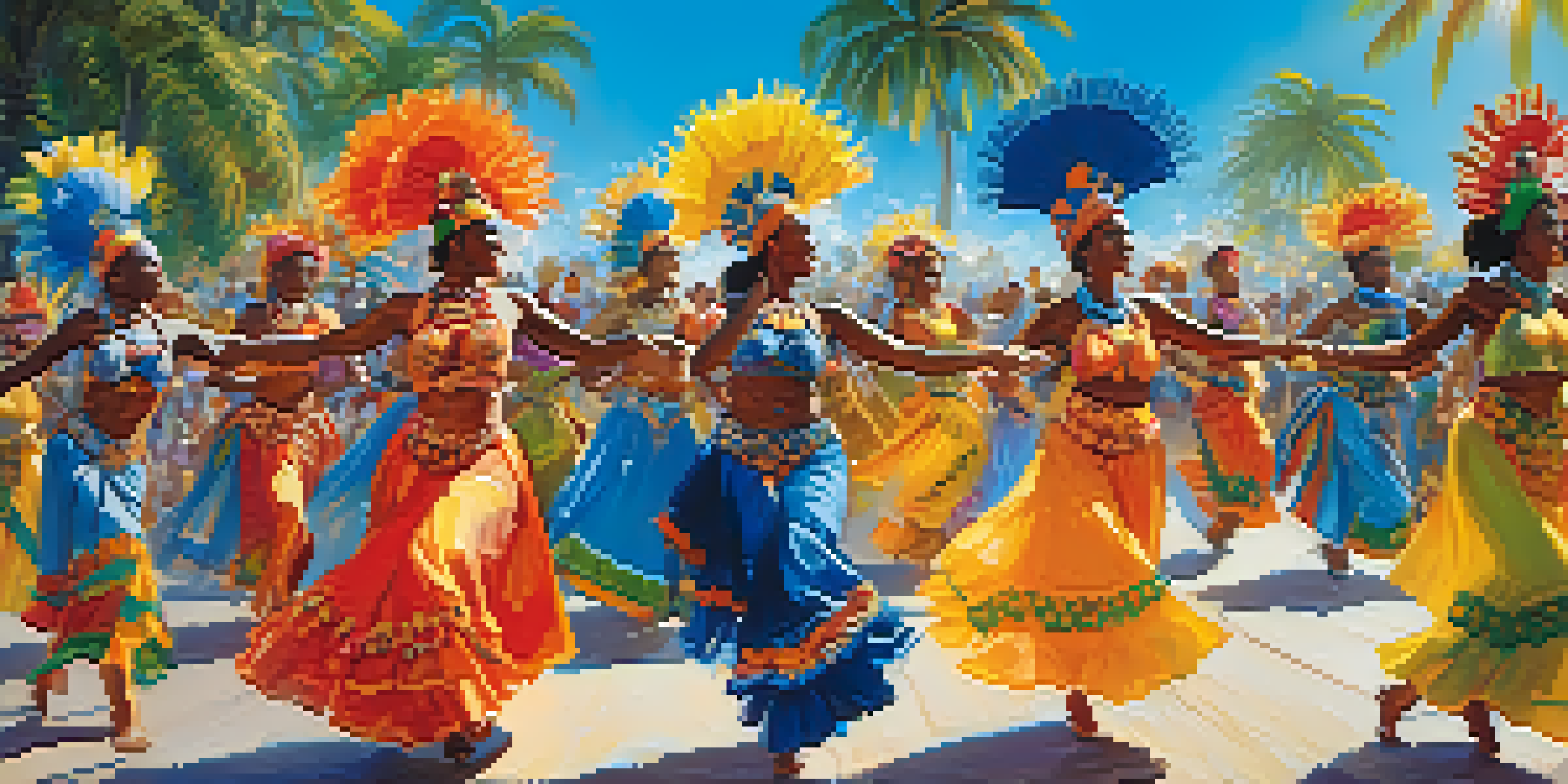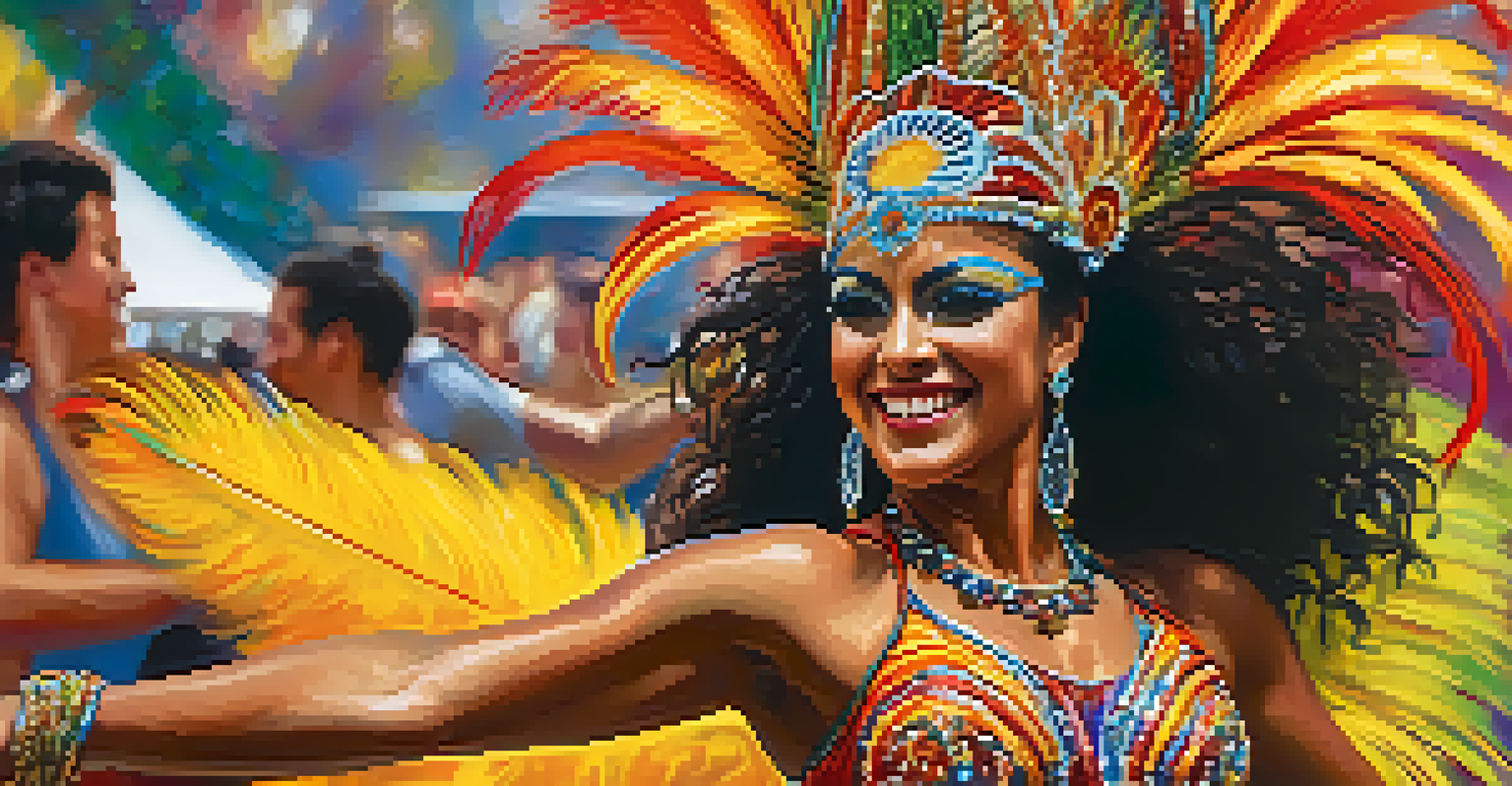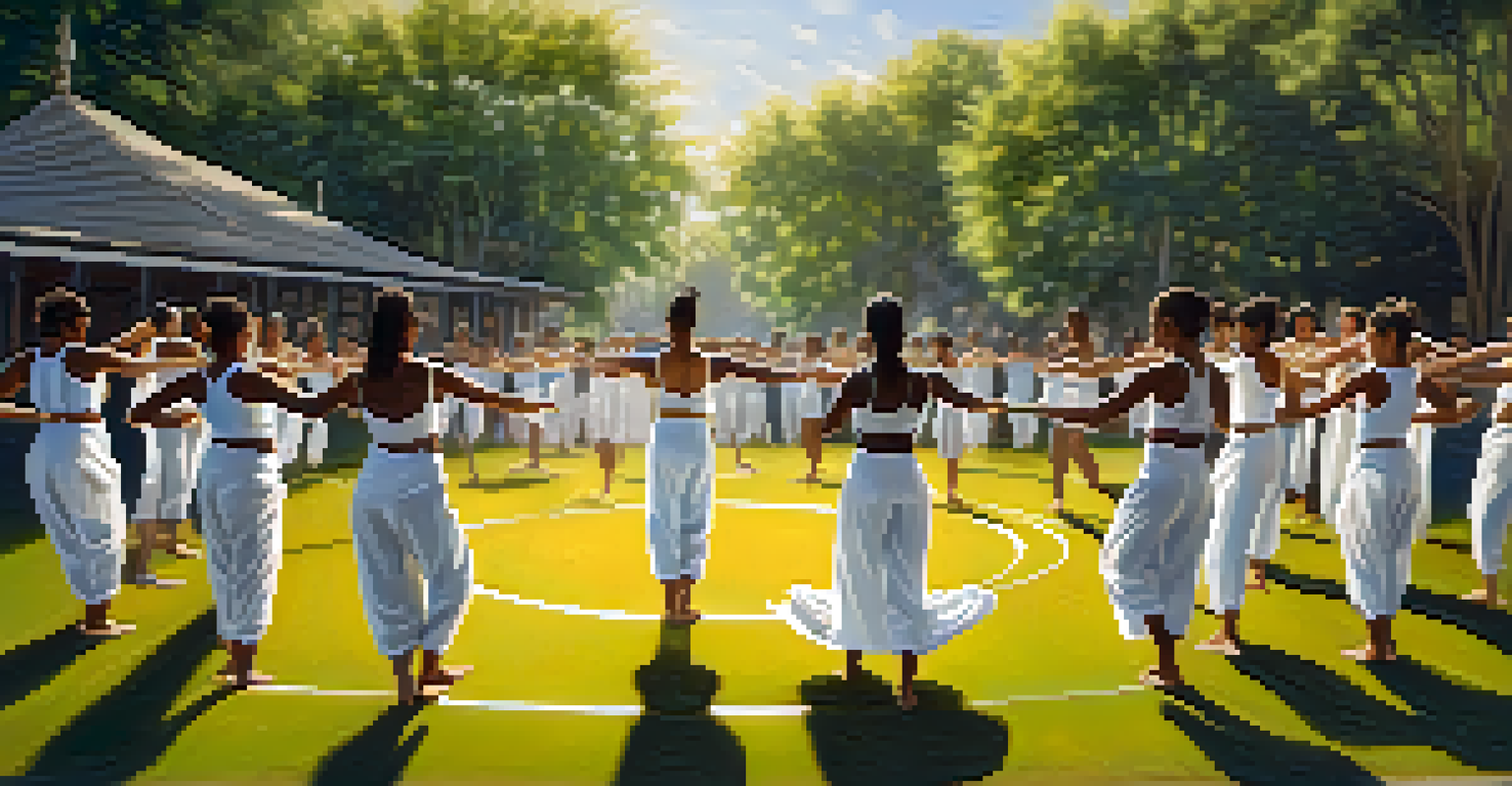The Influence of Afro-Brazilian Culture on Dance Trends Worldwide

Understanding Afro-Brazilian Culture and Its Roots
Afro-Brazilian culture is a rich tapestry that weaves together African traditions, Brazilian history, and indigenous influences. This dynamic blend emerged primarily due to the transatlantic slave trade, which brought millions of Africans to Brazil. Their cultural practices, particularly in music and dance, survived and evolved, forming the basis of many contemporary art forms.
Dance is the hidden language of the soul.
At its heart, Afro-Brazilian culture is about resilience and celebration, evident in its vibrant festivals and communal gatherings. These events often feature traditional music styles like samba and axé, which are accompanied by lively dance forms that have become synonymous with Brazilian identity. This cultural expression not only honors the past but also shapes the future of dance.
Understanding these roots helps to appreciate the profound impact Afro-Brazilian culture has had on dance both within Brazil and globally. As we explore its influence, we can see how these dances have transcended borders, resonating with diverse audiences and inspiring new forms of expression worldwide.
The Role of Samba in Shaping Global Dance Trends
Samba is perhaps the most iconic dance style to emerge from Afro-Brazilian culture, known for its infectious rhythm and vibrant movements. Originating in the Afro-Brazilian communities of Bahia, samba has become a global phenomenon, especially during the Rio Carnival. This annual celebration showcases the dance's energy and the cultural pride of Brazil, attracting millions of participants and spectators.

Beyond Brazil, samba's infectious beats and distinct steps have influenced various dance styles around the world. Dance enthusiasts and professionals often incorporate samba elements into genres like jazz, hip hop, and ballroom, demonstrating its versatility. The global dance community embraces samba not just for its rhythm but also for its ability to foster joy and connection among dancers.
Afro-Brazilian Culture's Resilience
Afro-Brazilian culture is a vibrant blend of African traditions and Brazilian history, characterized by its resilience and celebratory spirit.
Through workshops, performances, and social dance events, samba has spread beyond its cultural origins, creating a global appreciation for its artistic expression. This dance serves as a reminder of how cultural exchanges can enrich our lives and transform the dance landscape worldwide.
Cultural Fusions: Axé and Its Global Reach
Axé is another vibrant dance genre that showcases the dynamic nature of Afro-Brazilian culture. Originating in the 1980s in Bahia, axé music combines traditional Afro-Brazilian rhythms with pop influences, creating an upbeat and danceable sound. The dance style associated with axé is characterized by colorful movements and energetic choreography that invites participation from everyone.
The beauty of the world lies in the diversity of its people.
Axé has made waves internationally, particularly through its incorporation in dance fitness programs and music festivals. The infectious energy of axé dance attracts people from various backgrounds, allowing them to experience a slice of Afro-Brazilian culture. This phenomenon highlights how cultural fusions can create new trends that resonate across borders.
As axé continues to gain popularity, it serves as a bridge connecting diverse communities through shared enjoyment of music and dance. Its global reach demonstrates the power of cultural exchange in shaping dance trends and fostering unity through celebration.
Capoeira: Dance, Martial Art, and Cultural Identity
Capoeira is often described as a dance, a martial art, and a game, making it a unique expression of Afro-Brazilian culture. This practice emerged among enslaved Africans as a way to combine self-defense with artistic movement, disguised as a dance to avoid detection. The circular formation of the capoeira roda encourages participation and emphasizes the importance of community in this art form.
As capoeira gained recognition, it began to inspire various dance and martial arts enthusiasts around the globe. The fluid movements and rhythmic interactions between participants create a captivating performance that showcases agility and creativity. Capoeira's influence can be seen in dance styles and fitness programs that incorporate its movements, highlighting its adaptability.
Samba's Global Dance Influence
Samba, with its infectious rhythm, has transcended borders, influencing various dance styles and fostering joy among dancers worldwide.
Moreover, capoeira serves as a powerful symbol of resistance and cultural pride for the Afro-Brazilian community. As it spreads worldwide, it fosters a greater understanding of Afro-Brazilian heritage and contributes to the global appreciation of diverse cultural expressions.
The Influence of Afro-Brazilian Festivals on Dance
Afro-Brazilian festivals, such as Carnival and Festa de Iemanjá, are vibrant celebrations that showcase the region's rich cultural heritage. These events not only highlight traditional music and dance but also serve as a platform for contemporary artists to reimagine Afro-Brazilian traditions. Each festival presents an opportunity for participants to engage in dance styles that embody cultural narratives and social commentary.
The spirited atmosphere of these festivals often inspires dancers and choreographers globally, leading to the incorporation of Afro-Brazilian elements into various dance forms. The sense of community, joy, and cultural pride experienced during these celebrations transcends geographical boundaries, encouraging people to participate in the dance.
Furthermore, the global interest in these festivals highlights the importance of preserving Afro-Brazilian culture and its contributions to dance. As communities around the world embrace these traditions, they contribute to a dialogue that celebrates diversity and cultural richness through movement.
Afro-Brazilian Dance in the Age of Social Media
Social media platforms have transformed the way dance trends emerge and spread, and Afro-Brazilian dance is no exception. With the ability to share videos and tutorials, dancers worldwide can learn and engage with styles like samba, axé, and capoeira at the click of a button. This accessibility fosters a global community of dancers eager to connect with Afro-Brazilian culture.
Influencers and dance challenges often highlight Afro-Brazilian dance styles, showcasing their infectious energy and inviting participation from a broader audience. This phenomenon not only amplifies the reach of these dance forms but also encourages cultural exchange and appreciation. As people share their interpretations and adaptations, they contribute to the evolution of these traditional dances.
Capoeira: Art and Identity
Capoeira uniquely combines dance and martial arts, symbolizing cultural pride and resistance while inspiring global appreciation of Afro-Brazilian heritage.
Moreover, social media helps raise awareness about the cultural significance of Afro-Brazilian dance, fostering a deeper understanding of its history and roots. As more individuals engage with these styles, they help preserve and promote the rich heritage of Afro-Brazilian culture on a global scale.
Celebrating Diversity: The Future of Afro-Brazilian Dance
As we look to the future, the influence of Afro-Brazilian culture on dance trends shows no signs of waning. With an increasing focus on cultural diversity and inclusion in the arts, Afro-Brazilian dance styles will continue to inspire new generations of dancers. This ongoing evolution creates a rich tapestry of movement that reflects the experiences and stories of diverse communities.
Collaborations between Afro-Brazilian artists and dancers from various backgrounds further enrich the dance landscape, fostering creativity and cultural exchange. By blending different styles and techniques, these collaborations highlight the beauty of diversity and the shared human experience through dance.

Ultimately, the future of Afro-Brazilian dance lies in its ability to adapt and thrive in a global context. By celebrating its roots while embracing new influences, Afro-Brazilian culture will continue to leave an indelible mark on the world of dance, inspiring unity, joy, and creativity for years to come.